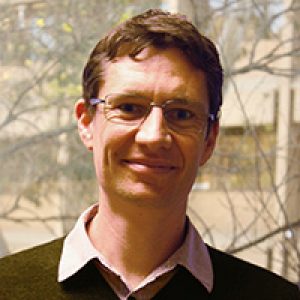
Battling a global pandemic with maths and stats
One of the few bright spots that has arisen out of the COVID-19 pandemic is that the profile of the mathematical sciences has increased significantly.
Leaders at the highest levels of government now understand the importance of mathematical and statistical thinking when making informed decisions.
Before 2020, a lot of people had never heard of mathematical modelling. Or, more specifically, epidemiological modelling. In fact, there were only a small group of researchers around Australia doing epidemiological modelling.
Dr Andrew Black was in that group. He had been studying the spread of epidemics for over a decade.
Early in 2020, Andrew was among a group of Australian epidemiologists who were closely watching the spread of a new coronavirus that had originated in China and was already starting to spread to other countries.
In March, he suddenly found himself thrust into what would be Australia's initial response to the Coronavirus when he and a few select others travelled to Canberra for a meeting with the Australian Department of Health. Australia had already closed its borders to China.
“Obviously, there were risks of people still bringing the virus to Australia from other parts of the world. We were asked to examine those risks and to start looking at the probabilities of seeing outbreaks as time went by,” says Andrew, a Lecturer at The University of Adelaide and an ACEMS Associate Investigator.
“I was quite involved with that modelling. It was a very intense few weeks of doing that work.”
The pandemic modelling team was led by Professor James McCaw from the School of Mathematics and Statistics at The University of Melbourne and Professor Jodie McVernon from the Peter Doherty Institute for Infection and Immunity. Following initial work on scenario analysis and planning, and with cases arriving in Australia, the team leaders established a situational awareness team. Real-time evaluation of the status of the epidemic and future activity forecasts would become an essential element of the response.
Since 2014, James McCaw and Dr Rob Moss, from the Centre for Epidemiology and Biostatistics at The University of Melbourne, had been developing forecasts for seasonal influenza. But the COVID-19 response required further skills. So, they turned to ACEMS Chief Investigator Rob Hyndman.
Rob is the head of the Department of Econometrics and Business Statistics at Monash University. For years, he’s helped companies and government agencies worldwide forecast things like product sales, energy usage, and tourism. But not epidemics.
“Forecasters and epidemiologists haven’t worked together much before. Epidemiologists usually study disease dynamics and measures to reduce transmission. But with a pandemic occurring, we needed to join forces to provide the best advice on how to manage the situation,” says Rob.
Rob’s job was to put together an ensemble forecast that combines forecasts from multiple models to get an overall forecast. One of the models he included was from an ACEMS team at The University of Adelaide. That team was led by Professor Josh Ross, who had also been researching and modelling the spread of epidemics for a decade.
“The pandemic is one of those things we always knew was inevitable, but still didn’t want to happen,” says Josh, an ACEMS Associate Investigator.
To help him, Josh enlisted ACEMS PhD candidate Dennis Liu and ACEMS Associate Investigator Dr Lewis Mitchell. Their model included Google mobility data about how people are mixing and interacting. It also included regular survey responses from people in Australia’s capital cities about their compliance to guidelines, like the 1.5-metre social distancing rule.
Rob also created a model to add to the ensemble. To help him with that, he enlisted the help of ACEMS postdoctoral researcher Dr Pablo Montero-Manso, who had already been doing pandemic modelling for his home country of Spain. The third model for the ensemble forecast was adapted from existing seasonal influenza forecasting models developed by Rob Moss in collaboration with Defence Science Technology Group and Australian states’ public health departments.
By the end of 2020, the models had matured quite a bit because a lot of information had been built in. They were quite nuanced
Rob Hyndman.
For Rob, this has been a very challenging but interesting experience.
“Sitting in on all those zoom calls for months, I’ve figured I’ve learned a lot about epidemiological modelling, how they do it and what they think about,” says Rob.
Rob has also taught them quite a bit about forecasting.
“As a forecaster, I’m not really interested in the average number of cases when we’re talking about something like a pandemic. I am more interested in the extremes, the upper tail of these probability distributions we were creating. To measure their accuracy, we needed probabilistic scoring methods.”
Their work continues in 2021.
In addition to the modelling and forecasting work advising the National Cabinet, ACEMS researchers tackled many different aspects of the crisis.

Prof James McCaw’s statement on the role of Australia’s mathematical sciences community in fighting the pandemic:
“Australia’s continued success throughout 2020, particularly post the Victorian second wave, has demonstrated the societal benefits of investment in the mathematical sciences. Sophisticated real-time analyses of the epidemic situation – providing estimates of the reproduction number and forecasts of likely future case numbers – have been delivered to key decision-makers at the state and federal level every week for 12 months. Analyses have helped drive change in testing and contact tracing policy and been used to inform policy responses to outbreaks in a number of states. As an invited expert on Australia’s peak health decision making body, the Australian Health Protection Principal Committee, it has been a privilege to draw on the outstanding work of my colleagues, ACEMS staff and affiliates in advising State and Commonwealth health leaders. As Australia’s vaccine program is rolling out, we will face new policy challenges. When we re-open society and the virus inevitably re-enters Australia, will it spread? If so, how quickly? And will the most vulnerable be safe? The mathematical sciences will continue to play a crucial role in our strategy and response in the months and years to come.”
ACEMS COVID-19 Research Workshop: July 2020
Here are some of their research projects:
ACEMS researchers at QUT used Bayesian statistics and mathematical modelling to assess the first six months of the global response to COVID-19. They used data from 158 countries. Read more
Chief Investigator Aurore Delaigle (UoM) examined the use of group testing to get a more efficient indication of the prevalence of COVID-19 in Australia. Read more
Associate investigator Melissa Humphries (UoA) was part of a national team that explored analysing wastewater samples to detect COVID-19 in certain areas. Listen to the podcast
Associate Investigator Lewis Mitchell (UoA) and Dr Nicolas Rebuli, past ACEMS PhD student were part of a team that explored the use of our mobile phones to risk map for outbreaks. Read more
ACEMS research fellow Laura Boyle (UoA) looked at the impact of the pandemic on South Australia’s emergency departments. Listen to the podcast
ACEMS research fellow James Walker and Associate Investigator Andrew Black (UoA) were part of the group that submitted the original paper on the spread of COVID-19 into Australia and the Asia Pacific. Read more
ACEMS Director Peter Taylor (UoM) is a member of the team developing Safe Blues technology for mobile phones. It’s designed to make inferences about how our social interactions affect the spread of the virus. Listen to the podcast; Visit the website

The Queensland Government awarded ACEMS Associate Investigator Nicole White (QUT) an Advance Queensland Industry Research Fellowship to use statistics to help critically ill COVID-19 patients.
The goal of her research will be to arm doctors and nurses with better decision-making tools that are backed by cutting-edge statistical analysis.
“My aim is to develop statistical models that describe the clinical course and treatment of COVID-19 patients from the time they are admitted to the ICU,” says Nicole, a statistician with QUT’s School of Public Health and an Associate Investigator with ACEMS.
There are limited drug treatments for COVID-19. One in ten patients hospitalised with COVID-19 require critical care.
“For example, we know some COVID-19 patients in the ICU experience acute respiratory failure,” says Nicole.
The statistical modelling will use patient-level information collected during a patient’s ICU stay to help inform medical staff identify which treatments are likely to be most effective for different patients. As part of modelling, Nicole is also interested in identifying subgroups of patients associated with different risks of COVID-19 induced acute respiratory failure.
“This information will help us to identify important factors associated with the commencement and effectiveness of a treatment or treatments in addition to patient survival,” says Nicole.
Nicole’s research will use data from the COVID-19 Critical Care Consortium’s international study of COVID-19 ICU admissions, which includes almost 400 hospitals and research facilities across 53 countries. QUT Professor Adrian Barnett, an Associate Investigator with ACEMS, is a Chief Investigator with the study and will work with Nicole on this project.
“It’s challenging to work in such a new space with the data changing daily, but it’s also incredibly rewarding to be part of the global effort to fight COVID-19,” says Adrian.
In the end, the research outcomes could be integrated into clinical practice, and provide clinicians access to relevant intelligence needed to support clinical decision making. The data will also be used to prepare for any more waves of the pandemic.
“It will contribute to future planning for any sustained pandemic responses or other circumstances that might overwhelm ICU capacity,” says Nicole.
The 2020 Advance Queensland Industry Research Fellowships were re-purposed to focus on research that could help during the COVID-19 pandemic.
In 2020, ACEMS members (highlighted) were authors on numerous publications and pre-prints that arose from COVID research. Read more here:
Risk mapping for COVID-19 outbreaks using mobility data
(Cameron Zachreson, Lewis Mitchell, Michael Lydeamore, Nicolas Rebuli, Martin Tomko, Nicholas Geard)
Key Questions for Modelling COVID-19 Exit Strategies (published in Proceedings of the Royal Society B)
(Robin N Thompson, T Deirdre Hollingsworth, Valerie Isham, Daniel Arribas-Bel, Ben Ashby, Tom Britton, Peter Challoner, Lauren H K Chappell, Hannah Clapham, Nik J Cunniffe, A Philip Dawid, Christl A Donnelly, Rosalind Eggo, Sebastian Funk, Nigel Gilbert, Julia R Gog, Paul Glendinning, William S Hart, Hans Heesterbeek, Thomas House, Matt Keeling, Istvan Z Kiss, Mirjam Kretzschmar, Alun L Lloyd, Emma S McBryde, James M McCaw, Joel C Miller, Trevelyan J McKinley, Martina Morris, Philip D ONeill, Carl A B Pearson, Kris V Parag, Lorenzo Pellis, Juliet R C Pulliam, Joshua V Ross, Michael J Tildesley, Gianpaolo Scalia Tomba, Bernard W Silverman, Claudio J Struchiner, Pieter Trapman, Cerian R Webb, Denis Mollison, Olivier Restif)
Modelling the Dynamics of the COVID-19 Population in Australia: A Probabilistic Analysis
(Ali Eshragh, Saed Alizamir, Peter Howley, Elizabeth Stojanovski)
Hindsight is 2020 vision: Characterisation of the Global Response to the COVID-19 pandemic (published in BMC Public Health)
(David Warne, Anthony Ebert, Christopher Drovandi, Antonietta Mira, Kerrie Mengersen)
Assessing the risk of spread of COVID-19 to the Asia Pacific region
(Freya Shearer, James Walker, Nefel Tellioglu, James McCaw, Jodie McVernon, Andrew Black, Nicholas Geard)
Modelling the impact of COVID-19 in Australia to inform transmission reducing measures and health system preparedness
(Robert Moss, James Wood, Damien Brown, Freya Shearer, Andrew J Black, Allen Cheng, James M McCaw, Jodie McVernon)